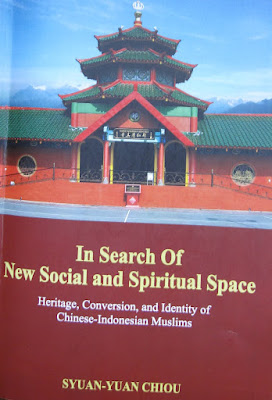They have a long history: some prominent Muslims of the 1930s until 1980s are Abdulkarim Oey (for whom Hamka wrote his Tasauf Moderen in 1937. The richest was definitely Haji Masagung who received so many orders from the Ministry of Religion, but besides confessing Islam also practised aspects of Javanese folk religion. He had a wonderful collection of daggers (keris) and used to clean these themselves and gave the water of the cleansing as medicine. The most active preacher was Yunus Yahya, long time leader of PITI, Persatuan Islam Tionghoa Indonesia.

On Friday 23 February Syuan-Yuan Chiou from Taiwan defended his dissertation in Utrecht in this topic. Like so many modern dissertations it was written as a series of articles and this was relevantg in this case, because the growing self-confidence of Chinese converts to Islam is not one great movements, but can be seen in many different aspects. There are some (five are described) mosques in Chinese style. The most spectacular is the new Zeng-He mosque of Surabaya. On the cover we see this recent building with a background of mountains, clouds or even snow. When we look to the black and white picture of p. 115 we see that this cover is the result of photo-shopping or alterations!
The black and white photograph belowe shows the real condition of the modest mosque (10x20 m) that is a quite impressive manifestations of the combination of Chineseness and Islam in Surabaya. There is no similar mosque in Jakarta, but some others are in Palembang, Bogor, Salatiga and Pandaan (East Java).
Chiou start his dissertation with the debate on Zeng He as Muslim admiral who travelled to the region in the period 1400-1430. The follows the practice of Salat Imlek, a short ritual prayer at Chinese New Year. It was allowed by a fatwa of the MUI, Majelis Ulama Indonesia of Yogyakarta in 2002. He has analysis of some 79 interviews and 56 conversion stories: not surprising most opt for Islam because of marriage/love affairs. He elaborates on some famous preachers who are popular among non-Chinese population. One group even sings nasheed in a Lampion (Chinese lanterns) style.
Most Chinese Muslims are from trading families and they are not religious specialists, but still earn money through trade. This could have been a good occasion to develop the theory of relation of Indoensian Islam and trade versus religious specialists: were it the Brahmans or ksatriya or rather the vaisya who brought Hinduism to Indonesia? What about the internal developments here? The theoretical sections now like to quote Pierre Bourdieu or theories about the rise of Islam in Western Europe: there must be theoretical analysis in a dissertation (or any academic book), but I like the theory to be close to the reality and not taken from absolutely different background!
You may download the dissertation soon through the programme http://igitur-archive.library.uu.nl/dissertations/2012.. Here Utrecht University makes available all its dissertations.
Just a few days before this Utrecht dissertation there was a lecture in Leiden by Wai-Weng Hew from Malaysia. He studied a similar subject and defended his thesis at ANU in Canberra in 2011. In Leiden he presented some of his results: about the mosques, the preachers and the Imlek Prayers. His work has not yet been published. I have some photographs of him, as shown above, besides Marieke Bloemberg who was the chair at the Leiden event.



Geen opmerkingen:
Een reactie posten